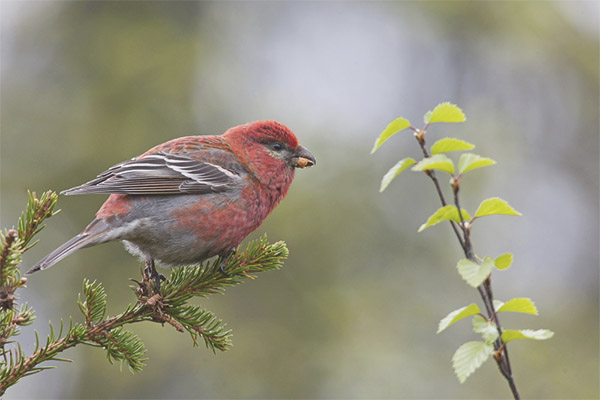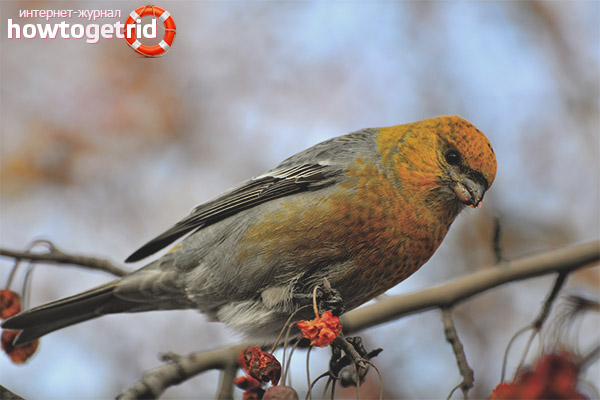The content of the article
Birds of the represented family are distinguished by their appearance and interesting behavior. Individuals sing very beautifully, so they attract attention to their personalities. You can listen to the wonderful voice of these kids not only in tropical zones, but also in northern latitude. We study all aspects in the next order.
Description
- By common schur is understood as a bird, otherwise called Finnish parrot or rooster. Of the entire family of finches and the order of passe-like, these individuals are considered the most colorful. The bird is slightly larger in size than the linnet, greenfinch, siskin and other representatives of this kind.
- Distinctive features of birds are, these signs differ among themselves depending on gender. As a rule, males are painted much brighter than females. The females are dull and unremarkable. Male members of the family are saturated and bright, they have a greater number of feathers pigmented in red and pink. The females are gray-yellow, motley.
- In males, feathers are scattered all over the body, alternating between each other in pinkish-red and gray colors. On the tail there are black shades, the same can be said about the tips of the wings. The body at the bottom is predominantly gray or yellowish-beige.
- In males, the thorax with head and neck is painted brightly in gray and red tones. The bill is swirling in its format, like that of a predator bird. The body is dense, knocked down, massive, rounded. In females, the head is predominantly gray, the brisket and neck are yellowish. Feathers alternate with gray and beige.
- In their way of life, these birds are very hidden, they sing beautifully and do not like to be near people. For existence, they choose places far away from a person in order to live peacefully, engage in the cultivation of offspring and their development.
- Birds love to sing, but they do it exclusively by individuals of the male gender. These individuals are especially audible when the mating season begins. But at other times of the year the birds do not fall silent. The song clearly hears friction and whistling, the nature of the compositions is sad, although the birds are cheerful and active.
Habitat
- The presented species of birds is quite common. Individuals live in coniferous and mixed forests. They are found in Asian and European countries, as well as in North America, Finland, and Russia.
- By their natural features, these birds love to settle in the crown of a tree. They are found in the mountains where juniper, elfin cedar and other species grow.
- Like other birds from the passerine, these individuals like to be in the wild forest, where a person rarely appears or does not appear at all. It was found that these individuals live not only in the steppe zone, but also near woody vegetation.
Nutrition
- Like other individuals from the family of the finch, the species of birds belongs to the healers of the forest. The grosbeak pulls pests out of the trunk, as well as seeds of bad plants.
- The basis of the diet is food of plant origin, but the birds are not against eating worms or bugs. Individuals eat seeds of vegetation and trees.
- In the spring, they go in search of buds, shoots, and foliage, and in the autumn, they are fed by spruce plants. They eat nuts, berry seeds and the fruits themselves.
- Can consume crops and grass seeds. Insects are not included in the basic diet, and act only as a supplement. Adults feed their chicks with bugs, rarely feed themselves.
Breeding
- The mating season in the birds in question begins in late spring. Only in rare cases, such behavior of birds can be seen in March. During mating games, the male tries to constantly fly around the female. He also performs beautiful trills. Such a melody can be compared to playing the flute.
- After mating has occurred between the adults, the female proceeds to the construction of a nest. This procedure often begins in late spring or early summer. At the same time at this time the male does not accept any participation. The female builds a nest at a small height, mostly away from the trunk.
- It is worth noting that the dwelling has a cup shape. At the same time the size of the nest is really amazing. Grass and twigs are used as building material. The litter is made of moss, wool and feathers. Often the female produces no more than 6 eggs,at the same time they have a bluish tint with dark patches.
- Vyskom future offspring, as mentioned earlier, is engaged exclusively in the female. After a little more than two weeks, the chicks are already beginning to emerge. At this time, the male provides the second half with food. He also feeds chicks after this. The female does not leave the dwelling and protects the young.
- As soon as the chicks are born, they already have gray down on their bodies. At the same time, they immediately begin to demand food. After birth, after another 3 weeks, the offspring are already trying to stand on the wing. At this time, they learn to fly. As soon as the young growth is over 1.5 months old, they begin to lead a completely independent lifestyle.
Interesting Facts
- In the people considered individuals are often called the "Finnish rooster" or "Finnish parrot." The birds got such nickname due to their bright color.
- These birds are very fond of water, so they can swim in open reservoirs, even in winter. As for the domestic content, individuals should be provided with a place for swimming.
- As mentioned earlier, the females of the species in question completely assume the construction of the nest.However, they do not allow the male to participate. Also, females are engaged in raising children.
Schnur is distributed quite extensively, a decent number of birds are concentrated in European countries. Otherwise, fluffy lumps are called Finnish parrots, because they repeat different sounds and look very colorful.
Video: schur (Pinicola enucleator)












To send